
|
|
Standards and MeasurementsAstronomy's Inventory of the Universe |
|


With bigger and bigger telescopes, astronomers cold view further into the universe - as it turned out beyond our home galaxy. But it was not yet clear, how all
these new discoveries were tied together.
 In Astronomy, the time from the late 18th to the mid 20th Century was mainly a time of catalogues, maps and standards. The most important catalogues are listed here in chronological order; for an extensive list, see Wikipedia, NASA and David Darling.  In addition to all of the inventory, new breakthroughs in physics, most notably the the Theory of Relativity and the Theory of Quantum Mechanics provided a better understanding of the complex dynamics of the universe.  The resolution of telescopes grew dramatically, allowing the discoveries of fain object like Ceres and Pluto. With the growing number of catalogued stars, the number of constellations grew - at one point (in 1801) to over one hundred. At the end of the 19th century, astronomers started to work out a standard, which resulted in 88 acknowledged constellations in 1928.  The primary focus of this site is not astronomy, but Star Lore, which is folklore based upon stars and star patterns. We try to create a collection of mythical stories about stars and constellations from all over the world. However, to better understand the myths and legends of stars and constellations, a brief history of the development of our modern constellations might be helpful. This is by no means a scientific paper on the history of astronomy, but merely an illustrated collection of highlights of that history, along with some links to what we think are reliable sources on the subject. |


Bits of the history of Astronomy from the late 18th to the mid 20th Century |


|
|
The Board of Longitude and the Nautical Almanach (1737, 1767)
In 1707, a fleet of four British warships ran aground off the Scilly Islands. The
disaster cost the lives of nearly 2,000 sailors.
|
 Nautical Almanach of 1767
Nautical Almanach of 1767Nautical Almanac Office |


|
|
Looking beyond stars and constellations - The Messier Catalogue (1781)
In 1781, French astronomer and comet hunter Charles Messier published a list of
diffuse objects that were not comets, to help comet hunters to distinguish between permanent and transient visually diffuse objects.
|
 Messier Catalogue
Messier CatalogueSource: SEDS |


|
|
The Flamsted Numbers - first used by Jérôme Lalande (1783)
In 1783, French astronomer Jérôme Lalande published
Éphémérides des mouvemens célestes, a revised edition of
Flamsteed’s catalogue
in French language.
|
 Éphémérides des mouvemens célestes
Éphémérides des mouvemens célestesSource: gallica.bnf.fr |


|
|
A Theory about Black Holes - 150 years ahead if its time (1783)
On November 27, 1783 English natural philosopher John Michell proposed a theory
of "dark stars" in a paper written for the Philosophical Transactions of the Royal Society of London.
|
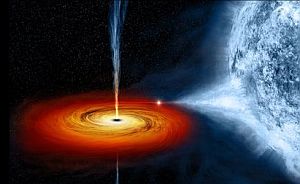 Black hole Cygnus X-1 pulls matter from the super giant blue star near it.
Black hole Cygnus X-1 pulls matter from the super giant blue star near it.Source: NASA-CXC-M.Weiss/www.nasa.gov |
Mitchell reasoned that there might be many "dark stars" in the universe. He also proposed that "dark stars" could be detected by their effects on other
stars. This was an amzingly correct prediction as shown in the picture above, where gas from a blue supergiant is spiraling into a companion black hole.
 The Reverend John Mitchell did groundbreaking work in astronomy, geology, optics, and gravitation. The American Physical Society described Michell as being so far ahead of his scientific contemporaries that his ideas languished in obscurity, until they were re-invented more than a century later.  Source: Wikipedia |


|
|
The Great Jupiter–Saturn Inequality (1784)
In three sections, in 1784, 1785, and 1786, French scholar and polymath Pierre-Simon, marquis de Laplace
presented a memoir on planetary inequalities, now known as the "great Jupiter–Saturn inequality". Laplace solved a longstanding problem in the study
and prediction of the movements of these planets by identifying the perturbations,
which is the complex motion of a massive body that is subject to forces of an additional body other than the one on the focus of its orbit.
|


|
|
Connecting the Dots - Nouvelle Uranographie (1786)
Today, the most common depiction of a constellation is a diagram of the brightest stars, connected by thin lines. One could easily assume that this has been
the common wayto depict constellations for a long time, but up until the the late 18th century, all constellations were described by rather elaborate
pictures. The geometrical rendering of the constellations was invented by an almost forgotten French astronomer.
|
 Ruelle's renderings of Ursa Major and Ursa Minor
Ruelle's renderings of Ursa Major and Ursa MinorSource: Teca Digitale Viewer |
"Alexandre Ruelle (1756–18??) [was] an assistant at Paris Observatory in pre-revolutionary France. Extending the growing revolutionary fervour to the
sky, Ruelle swept away the conventional constellation shapes of the astronomical ancien régime and substituted a sparer, more proletarian style. He
presented his results in 1786 on a chart titled Nouvelle uranographie, consisting of northern and southern hemispheres with an equatorial strip below.
In the accompanying booklet he explained his rationale:
 I thought there could be no simpler and easier way of teaching the knowledge of the sky than to substitute for these fantastic figures triangles, squares, polygons or other geometric figures which really make visible the various groups of stars by supposing the brightest stars of each constellation linked together by lines."  Ruelle's concept took on only slowly. Two of the most popular presentatations of constellations as pictures (Bode's Uranographia and Urania's Mirror) were published 15 and 38 years respectively, after Ruelle's publication. Today, however, the "Matchstick Men" are the most common way to depict constellations. |

|
There is no official rule of how to draw the lines between the stars of a constellation, leaving some room for creative interpretations.
 Sources: Ian Ridpath: Pictures of Matchstick Men, Anthony Auerbach: Joining the Dots |


|
|
Catalogue of Nebulae and Clusters of Stars (1786)
In 1786, German-born British astronomer William Herschel and his sister
Caroline Herschel published the
Catalogue of Nebulae and Clusters of Stars which originally
had 1,000 entries. Two additions in 1789 and 1802 brought it to 2,500 objects - a huge step up from
Messier's catalogue just 20 years earlier.
|


|
|
New Tables for Planetary Movement (1792)
In 1782, while recording a transit of Mercury across the Sun, French astronomer
Jean Baptiste Joseph Delambre noticed, that the existing tables
on planetary movement were inaccurate. He then devoted much effort into producing new ones.
|


|
|
Exposition du Système du Monde (1796) In 1796, de Laplace published his findings on the Great Jupiter–Saturn Inequality in Exposition du système du monde (Exhibition of the Wold System). Mécanique Céleste (1799 - 1825) In 1799, the first two volumes of de Laplace's Mécanique céleste (Celestial Mechanics) are published. They contained methods for calculating the motions of the planets, determining their figures, and resolving tidal problems. |

|

|
The third and fourth volume were published in 1802, 1805. They contained mathematical applications to solve astronomical problems and
and several astronomical tables.
 The last volume was published in 1825. It was mainly historical, but also had appendices containing the results of Laplace's latest researches, especially his Nebular hypothesis.  Based on the findings of Emanuel Swedenborg and Immanuel Kant, de Laplace concluded that the Sun and all the planets of our Solar System began as a giant cloud of molecular gas and dust which later collapsed into a new star (the Sun) with some of the material forming a protoplanetary disc from which the planets evolved.  Sources: A.Pannekoek, The planetary theory of Laplace 
 Wikipedia,
Universe Today,
Wikipedia,
Universe Today,
|

|


|
|
The Beginning of Astronomical Spectroscopy (1800, 1814)
In 1800, William Herschel split sunlight through a prism and measured
the energy given out by different colors. His experiments laid the foundations of
astronomical spectroscopy.
In 1814, Bavarian physicist Joseph von Fraunhofer build the first
accurate spectrometer and used it to study the spectrum of the Sun's light. He discovered and studied the dark
absorption lines in the spectrum of the sun now known as
Fraunhofer Lines.
|

|


|
|
Ceres and the Asteroid Belt (1801)
As early as 1772, Johann Elert Bode, director of the Berlin Observatory suggested that an undiscovered planet could exist between the
orbits of Mars and Jupiter.
|

|
 When a second object (Pallas) was discovered in 1802, William Herschel suggested the term asteroid (little star), which prevailed over Piazzi's more precise sugestion planetaroid (little planet).  By 1860, more than 60 asteroids had been discovered and the area between the orbits of Mars and Jupiter became known as the Asteroid Belt.  Source: Wikipedia, David Darling |


|
|
100 Constellations and more - Bode's Uranographia (1801)
In 1801, Bode published a star catalogue called
Allgemeine Beschreibung und Nachweisung der Gestirne (Description and Calculation of
Celestial Bodies). It listed 17,240 stars and came with a large star atlas illustrated with twenty copper plates, called
Uranographia sive astrorum.
|
 Uranographia title page
Uranographia title pageSource: Linda Hall Library |


|
|
47,390 stars - Histoire Céleste Française (1801)
Bode's Uranographia listed 17,240 stars. At the same time as Bode published his
catalogue in Berlin, his French colleague
Lalande, after a decade of astronomical recordings taken at the
Paris Observatory put together a catalogue listing almost three times as many stars.
|

|


|
|
Praecipuarum Sellarum Inerrantium (1803)
Starting in 1792, Sicilian astronomer Giuseppe Piazzi, the discoverer of the first asteroid,
started overseeing the compilation of the Palermo Catalogue of stars, containing 7,646 star entries.
|
 Praecipuarum Sellarum Inerrantium
Praecipuarum Sellarum InerrantiumSource: Google Books |


|
|
Royal Astronomical Society (1820)
On March 10, 1820, the world's first society for the the study of astronomy, the Astronomical Society of London was founded. In 1831, it became the
Royal Astronomical Society.
|
 150th anniversary stamp
150th anniversary stampPostal Museum, Ian Ridpath |
Currently, the society has over 4,000 members, most of them professional researchers or postgraduate students.
 Sources: Royal Astronomical Society, Wikipedia |


|
|
A Celestial Atlas (1822)
Celestial Atlas was a star atlas by British author
Alexander Jamieson, published in 1822. It was inspired by Bode's
Uranographia, but limited to stars visible with
the naked eye, making it less cluttered.
|

|


|
|
Urania's Mirror - the most popular depictions of the constellations (1824)
Two years after Jamieson's Celestial Atlas, Urania's Mirror, featuring a set of 32
astronomical star chart cards, was published. The brightly colored cards were inspired (or plagiarized) by Jamieson's drawings, but in addition, they had holes
punched in them allow them to be held up to a light to see a depiction of the constellation's stars.
|
 Scorpius in Urania's Mirror
Scorpius in Urania's MirrorSource: Wikipedia |

| Urania's Mirror marked the end of a thousand year-long marriage between astronomy and art. From now on, astronomy was presented in tables and diagrams rather than artistic renderings. However, a growing awareness of national identities led to a rennaicance of Astro-Art in the early 21st century. In our Star Lore Art section, we provided some examples of artistic interpretations of Native American and Australian Aboriginal constellations. |


|
|
Geography of the Heavens (1833)
US-American astronomer Elijah Hinsdale Burritt is often called
the "Forgotten Astronomer", as most astronomy history books don't even mention his name.
|
 Burritt's Geography of the Heavens; osr.org
Burritt's Geography of the Heavens; osr.org
|
| Sources: Albert J. Brooks: The forgotten Astronomer, osr.org, historical.ha.com, astronomy.com |

|
Star Names coined in the Geography of the Heavens A number of star names were first listed in Burritt's catalogue and map. Some of them were his own creations, others were already in use but were first listed by him. |
Star
 β Carinae α Centauri α Crucis β Crucis γ Crucis υ Orionis |
Name
 Miaplacidus Bungula Acrux Becrux Gacrux Thabit |
Description
 From "miyāh" (Arabic for water) and "placidus" (Latin for placid); Burritt's creation Possibly from "β" and "ungula" (Latin for hoof); Burritt's creation From "Alpha" and "Crux"; used by navigators and picked up by Burritt From "Beta" and "Crux"; used by navigators and picked up by Burritt From "Gamma" and "Crux"; likely Burritt's creation From "al-thabit" (Arabic for endurer) likely Burritt's creation |


|
|
Double Stars (1837)
Baltic German astronomer Friedrich Georg Wilhelm von Struve had
been observing double stars at the
Dorpat Observatory in what is now Estonia.
XXXXXXXXXXXXXXXXXXXXXXXCatalogus novus stellarum duplicium, source: ETH-Bibliothek |

|


|
|
Measuring the Distance of a Star (1838)
In 1838, German astronomer and mathematician Friedrich Bessel conducted the first
successful measurement of the didstance of a star (other than than the sun). Using the method of
stellar parallax, the effect of Earth's annual movement around the Sun, he calculated the distance
to 61 Cygni at about 10.4 light-years, very close to the actual value of about 11.4 light-years.
|


|
|
The Beginning of Astrophotography (1840)
In 1837, French artist Louis Daguerre invented the first publicly available photographic
process, later known as Daguerreotype. In 1839, his attempt to take a picture of the Moon
fails due to overexposure.
|
 First Photograph of the Moon
First Photograph of the MoonSource: Wikipedia |


|
|
The Solar Cycle (1843)
For 17 years, German astronomer Heinrich Schwabe observed the sun trying to detect the
passage of a hypothetical planet inside the orbit of Mercury. He didn't discover a new planet, but instead noticed the
Solar cycle, a regular variation in the number of sunspots.
|
 Sunspots;
NASA
Sunspots;
NASA
|


|
|
The Largest Telescope of the 19th Century (1845)
From 1842 to 1845, Anglo-Irish astronomer
William Parsons, 3rd Earl of Rosse
had a large reflecting telescope of 72 inches built at Birr Castle in Ireland.
|
 Leviathan;
Wikipedia
Leviathan;
Wikipedia
|
The title of above mentioned publication was Observations of Nebulae and Clusters of Stars Made With the Six-foot and Three-foot Reflectors at Birr Castle
From the Year 1848 up to the Year 1878.
 Source: Wikipedia |


|
|
The "Spiral Nebula" (1845)
Parson's perhaps most important discovery using the "Leviathan" was the observation of Messier
object M51. This was thought to be a nebula, but Rosse's observation revealed its spiral character. Today, this nebula is known as the
Whirlpool Galaxy.
|
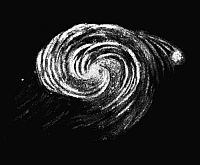 Whirlpool Galaxy;
Wikipedia
Whirlpool Galaxy;
Wikipedia
|


|
|
Neptune (1846)
In 1846, French astronomer and mathematician Urbain Le Verrier predicting the existence
and position of an outer planet based on the orbit of Uranus, based on discrepancies with Uranus's orbit and the laws of Kepler and Newton. He
sent the coordinates to Johann Gottfried Galle in Berlin, who found Neptune in the
same night he received Le Verrier's letter, within 1° of the predicted position. The discovery of Neptune is widely regarded as a dramatic validation
of celestial mechanics, and is one of the most remarkable moments of 19th-century science.
|


|
|
Counting the Northern Stars (1859)
In 1859, Friedrich Wilhelm Argelander at the Bonn Observatory in Germany started
compiling the positions and apparent magnitudes of all known stars. Over the course of 44 years Argelander and his assistants collected the data of
approximately 325,000 stars to apparent magnitude 9–10.
|


|
|
Spectral Classes (1866)
Italian priest and astronomer Angelo Secchi
was one of the pioneers of astronomical spectroscopy.
|

|


|
|
The Toronto Astronomical Club (1868)
In the mid-1800s, small high resolution telescopes became available to the public and soon star gazers all over the world gathered in clubs and observed
the night sky.
|
 Royal Astronomical Society of Canada
Royal Astronomical Society of Canada |


|
|
Spectral Photography (1872)
The first records of solar and stellar spectra were taken by
William Herschel and
Joseph von Fraunhofer in the early 1800s
(see above) and then in 1863 by
Angelo Secchi.
|

|
In 1880, Henry Draper photographed the spectrum of Jupiter. Before his death in
1882 he took over a hundred more photographs of stellar spectra.
 Source: Wikipedia, Linda Hall Library |


|
|
Uranometria Argentina (1874)
In 1868, US-American astronomer Benjamin Gould was invited by the Argentinian
government to organize the Argentine National Observatory in
Córdoba. From 1871 until 1885, Gould was the Observatory's director.
|

|


|
|
Drawing Lines between Constellations (1874)
While working on his Uranometria Argentina, US-American
astronomer Benjamin Gould tackled a problem that arose with the invention of the telescope:
|
 Gould's Border between
Gould's Border betweenLupus and Centaurus Source: Paolantonio, Garcia |
Gould was the first one to draw border lines between constellations using arcs of right ascension circles and parallels of declination. With that
approach, every star could be assigned to one of the traditional constellations.
 In 1928, when the International Astronomical Union standardized the star maps, Gould's boundaries of the southern constellations was addopted almost without change and his concept was extended to the constellations of the northern hemisphere.  Source: Paolantonio, Garcia: Uranometria Argentina and the constellation boundaries |


|
|
The Harvard Computers (1875)
The Harvard Computers were a group of skilled women processing astronomical data at the
Harvard Observatory.
|
 Harvard Computers
Harvard ComputersSource: Wikipedia |


|
|
The Moons of Mars (1877)
US-American astronomer Asaph Hall III had calculated the probability of a small moon in a close orbit around
Mars. On August 12 and August 18, 1877, respectively, using the telescope at the
US Naval Observatory (USNO) in Washington, DC, Hall discovered first
Deimos, then Phobos.
|

|


|
|
Harvard Photometry (1884)
Supervised by US-American astronomer Edward C. Pickering,
The the Harvard College Observatory compiled a catalogue listing
about 4,000 stars. The Harvard Photometry
was first published in 1884.
|


|
|
Dark Bodies (1884)
Dark Matter seems to be a fairly new concept, but it has been discussen in the scientific community for over a hundred years.
|

|
Dutch astronomers Jacobus Kapteyn and
Jan Oort
discussed the phenomenon in 1922 and 1932, respectively.
 In 1933, the term finally stuck, when Swiss astronomer Fritz Zwicky delivered theoretical proof of the concept and called it Dunkle Materie, which is German for - again - dark matter.  Sources: Wikipedia, Lord Kelvin: Baltimore Lectures on Molecular Dynamics and the Wave Theory of Light |


|
|
The Andromeda Supernova (1885)
Between August 17 and August 20, 1885 several astronomers discovered a light burst in the "Andromeda Nebula." German astronomer
Ernst Hartwig at the
Dorpat Observatory in what is now Estonia was the first one to identify it as a
Nova.
|


|
|
First Picture of another Galaxy (1888)
Welsh hobby astronomer and astrophotographer Isaac Roberts developed a
methode to take long exposure photographs of faint object by mounting his camera on a larger equatorial mounted telescope that would
constantly adjust to the Earth's rotation and would keep the camera aimed accurately in the same direction for the required time, which could
be an hour or more.
Orion.
|

|
The photograph revealed that the "nebula" had a spiral structure, which was quite unexpected at the time. The Photograph caused a "quantum leap"
in astronomy as it made clear that this was not a nebula.
 The confirmation that the "Andromeda Nebula" was a galaxy was made by Edwin Hubble in 1924.  Source: Wikipedia |


|
|
The Horsehead Nebula (1888)
While analyzing a telescope-photogrammetry plate made by astronomer
W. H. Pickering, brother of E.C. Pickering, Harvard Computer
Williamina Fleming discovered a small but distinct
dark nebula in the constellation
Orion.
|

|


|
|
NGC - The New General Catalogue (1888)
In 1878, Danish astronomer John Louis Emil Dreyer published a supplement to
William Herschel's Catalogue of Nebulae and Clusters of Stars.
|
 New General Catalogue
New General Cataloguearchive.org |


|
|
Draper Catalogue of Stellar Spectra (1890)
In the 1880s, Harvard astronomer Edward Charles Pickering started a
survey of stellar spectra. Harvard computer Williamina Fleming was credited
with classifying over 10,000 featured stars and discovering 10 novae and more than 200 variable stars.
|
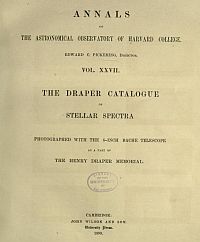 Draper Catalogue of Stellar Spectra
Draper Catalogue of Stellar Spectraarchive.org |


|
|
Astronomische Gesellschaft Katalog (1890)
From the day it was founded in 1863, the Astronomische Gesellschaft started working on
a star catalogue based on the data compiled by Based on Friedrich Wilhelm Argelander.
|
 1904 edition of the Katalog
1904 edition of the KatalogSource: archive.org |


|
|
Counting the southern Stars (1892-1900)
The original Astronomische Gesellschaft Katalog listed only stars
visible from Europe. In order to create a comprehensive catalogue, the Astronomische Gesellschaft conducted two additional surveys, one from Capetown,
South Africa and one from Córdoba, Argentina.
|

|

|


|
|
Yerkes Observatory (1892)
Founded in 1892 by astronomer George E. Hale and financed by businessman
Charles T.Yerkes, the
Yerkes Observatory in Williams Bay, Wisconsin represented a shift in the thinking
about observatories, from their being mere housing for telescopes and observers, to a concept of observation equipment integrated with laboratory
space.
|

|


|
|
Spectra of Bright Stars (1897)
In 1897, Harvard computer Antonia Maury published a stellar classification
catalogue called Spectra of Bright Stars Photographed with the 11-inch Draper Telescope as Part of the Henry Draper Memorial.
|
 Spectra of Bright Stars
Spectra of Bright StarsSource: Linda Hall Library |


|
|
A Standard Candle for the Milky Way (1899)
In 1899, Harvard computer Williamina Fleming discovered the star
RR Lyrae, the brightest star of a class called
RR Lyrae variable.
|


|
|
A Book about Star Lore (1899)
Richard Hinckley Allen, born in 1838, Buffalo, New York wanted to become an astronomer, but his poor eyesight crashed his dream. Instead of discovering
new stars, he collected stories about the existing ones. His book
Star Names: Their Lore and Meaning , published in 1899 was the
first comprehensive collection of astronomical information about stars and constellations, paired with the myth and legend behind them. He collected
Greco-Roman stories as well as Arabic, Babylonian, Indian and Chinese myth.
|

|


|
|
Quantum Mechanics (1900)
At the turn of the century, theoretical physicists started rethinking the microworld. German physicist
Max Planck found energy in packets he called quanta. This was the beginning of
Quantum Mechanics.
|
 Artist's visualization
Artist's visualizationSource: letstalkscience.ca |


|
|
Mount Wilson Observatory (1904)
In 1904, George E. Hale moved the
Snow Sun Telescope from the
Yerkes Observatory in Wisconsin to a new location at
Mount Wilson in Southern California.
|
 Snow Solar Telescope in 1912
Snow Solar Telescope in 1912Source: mtwilson.edu |


|
|
E = mc2 (1905)
On September 26, 1905, German born physicist Albert Einstein published his
Theory of Special Relativity regarding the relationship between space and time.
|
 Einstein's Formula
Einstein's FormulaAltes Museum, Berlin Source: redbubble.com |


|
|
The Burnham Double Star Catalogue (1906)
Designed by US-American astronomer Burnham Wesley and published by the
Carnegie Institution for Science, this catalogue listed
13,665 pairs of double stars.
|
 Burnham Double Star Catalogue
Burnham Double Star CatalogueSource: Abe Books |


|
|
Hertzsprung–Russell Diagram (1906, 1912)
In 1906, Danish chemist and astronomer Ejnar Hertzsprung established a standard for
measuring the true brightness of a star by showing a relationship between color and absolute magnitude for 90% of the stars in the
Milky Way.
|
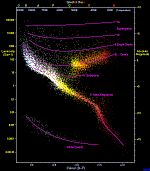 H–R Diagram
H–R DiagramSource: Wikipedia |


|
|
Harvard Revised Photometry (1908)
The Harvard Photometry of 1884 covered only the northern
hemisphere.
|


|
|
The Tunguska Event (1908)
On the morning of June 30, 1908, a massive explosion occurred near the
Podkamennaya Tunguska River in the
Eastern Siberian Taiga.
|
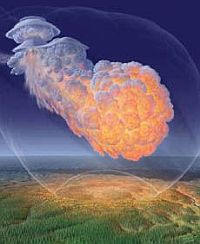 Artist's concept of the Event
Artist's concept of the Eventskyandtelescope.org |


|
|
Mount Wilson's 60-inch Telescope (1908)
While astronomer George E. Hale is credited with the foundation of
the Mount Wilson Observatory, almost all of the
early instruments were designed and built by astronomer and engineer George W. Ritchey.
|
 Ritchey's photograph
Ritchey's photographof the Orion Nebula Source: mtwilson.edu |
In 1919, George Ritchey used the telescope to to locate faint light from erupting novae stars in spiral nebulae, suggesting that they were at
extreme distances away from Earth and thus fueling the debate
about galaxies other than the Milky Way.
 Sources: Wikipedia, mtwilson.edu, space Today |


|
|
Norton's Star Atlas (1910)
In 1910, British schoolmaster Arthur Philip Norton created a new kind of star atlas. His
star charts divided the sky into six vertical slices, or gores, like portions of a globe. Each gore covered 4 hours of right ascension, from
declination 60 degrees north to 60 degrees south. The north and south polar regions of the sky were covered by separate charts.
Harvard Computer
The atlas came with observing handbooks written by British astronomers William Henry Smyth
and Thomas William Webb.
|
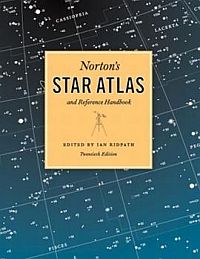 Norton's Star Atlas
Norton's Star AtlasSource: abebooks.com |


|
|
White Dwarfs (1910)
The triple star system 40 Eridani was discovered in 1783. In 1910,
Harvard Computer
Williamina Fleming, together with
Henry Norris Russell and
Edward Charles Pickering had a second look at the system and discovered that
one of the stars 40 Eridani B, despite being a dim star, was of spectral type A, or white.
|
 Artist's concept of a white dwarf
Artist's concept of a white dwarfSource: spaceanswers.com |
The physics of a White Dwarf were explained in 1926 by British physicist and astronomer
Ralph H. Fowler, using
Quantum statistics.
He described White Dwarfs as stellar core remnants composed mostly of electron-degenerate matter.
A white dwarf is very dense: its mass is comparable to that of the Sun, while its volume is comparable to that of Earth.
 In 1930, Indian-American astrophysicist Subrahmanyan Chandrasekhar calculated the maximum mass of a stable white dwarf star. This value is now called the Chandrasekhar Limit.  Source: Wikipedia |


|
|
Martians! (1911)
In 1877, Italian Astronomer Giovanni Schiaparelli observed the surface of
Mars and named some of its features. Among them was a dense network of linear structures,
which he called canali, which is Italian for channels, meaning features of natural origin.
|
 Schiaparelli's surface map of Mars.
Schiaparelli's surface map of Mars.Source: Wikipedia
|


|
|
The Harvard System (1912)
In 1901, Harvard Computer Annie Jump Cannon started working on the still unfinished
spectral classification of stars.
|
 Spectral classes
Spectral classeson the H–R Diagram Source: Wikipedia |


|
|
A Standard Candle for long Distances (1912)
Cepheid variable are pulsating stars producing changes in brightness with a
well-defined stable period and amplitude. The first one, η Aquilae was discovered in 1784
by English astronomer Edward Pigott.
|
 luminosity and period
luminosity and periodSource: Universe Today |
Since their discovery in 1899, RR Lyrae Variable stars were used as a
standard candle for distances within the Milky Way. But these stars appeared mostly in clusters
within our galaxy. Leavitt's discovery provided astronomers with the first standard candle
with which to measure the distance to faraway objects.
 Source: Wikipedia |


|
|
Ptolemy's Almagest after almost two Millennia (1915)
English astronomer Edward Ball Knobel started out in 1872 as an amateur with a 8.5 inch
reflecting telescope and eventually, in 1900 became president of the
Royal Astronomical Society.
|

|


|
|
Spacetime (1915)
In 1915, Albert Einstein published the
Theory of General Relativity, providing a unified description of gravity as a
geometric property of space and time or four-dimensional spacetime.
|

|


|
|
The nearest Star (1915)
In 1915, Scottish astronomer Robert Innes, director of the
Union Observatory in Johannesburg, South Africa discovered a
red dwarf belonging to the
the Alpha Centauri system. With a distance of 4.244 light years,
Proxima Centauri is the closest star to our sun.
|
 Hubble Telescope image
Hubble Telescope imageof Proxima Centauri Source: ESA |
|
|
The second nearest Star (1916)
Shortly after the discovery of Proxima Centauri, US-American astronomer Edward Emerson Barnard
discovered another Red Dwarf with a very large
proper motion, relative to other stars.
|


|
|
Island Universes (1917)
In 1917, US-American astronomer Heber Curtis, examining photographs of a
novae in the "Andromeda Nebula", concluded that the object was too far away to be part of the
Milky Way galaxy. He became a proponent of the so-called "island universes"
hypothesis, which held that spiral nebulae were actually independent galaxies.
|

|


|
|
The Hooker telescope (1917)
Funded by amateur astronomer and philanthropist John Daggett Hooker, the world's first
100-inch telescope was completed in 1917 at the
Mount Wilson Observatory in southern California.
|
 Hooker Telescope at Mt. Wilson Observatory
Hooker Telescope at Mt. Wilson ObservatorySource: National Public Radio |
Until the completion of the Hale Telescope in 1949,
the Hooker Telescope was the
largest telescope in the world.
 Sources: Wikipedia, mtwilson.edu, npr.org |


|
|
Henry Draper Catalogue (1918)
The Henry Draper Catalogue is named after
Henry Draper, who in 1872 made the first photograph of a star's spectrum showing distinct spectral lines
and pioneered the classification of stellar spectra.
|

|
Today, the catalogue contains 359,083 stars and its catalogue numbers are commonly used as a way of identifying stars.
 Sources: Wikipedia, Astro Index |


|
|
Gravitational Lense (1919)
On May 29, 1919, British astronomer Arthur Eddington observed a total
eclipse of the Sun in order to confirm Einstein's
theory of general relativity. According to
Einstein's theory, stars with light rays that passed near the Sun would appear to have been slightly shifted because their light
had been curved by the Sun's gravitational field - an effect now known as
gravitational lensing.
|
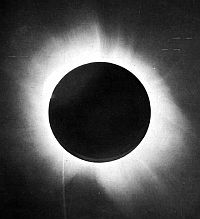 Eclipse of 1919
Eclipse of 1919Source: Wikipedia |


|
|
Barnard Catalogue (1919)
In 1895, Edward Emerson Barnard began taking detailed pictures of the
Milky Way. Barnard became especially interested in
Dark nebulae obscuring the view of the Milky Way.
|
 Nebula Barnard 68
Nebula Barnard 68Source: Wikipedia |


|
|
Finding our place in the Galaxy (1919)
Ever since Copernicus had placed the Sun in the center of our
solar system, it was assumed that the Sun was close to the center of the Galaxy, thus at least all the other stars would still rotate around us.
|

|
| From this conclusion, Shapley deduced that the Sun lies at a distance of about 50,000 light-years from the centre of the Galaxy; the number was later corrected to 30,000 light-years. |
 Shapleys observations led to the first realistic estimate for the actual size of the Milky Way. Today, we know (to the best of our knowledge) that Milky Way is about 150,000 to 200,000 light-years across, about 2,000 light-years deep, and has 100 to 400 billion stars.  Our Sun is located in the Orion-Cygnus Arm of the Milky Way, some 27,000 light years away from the center. We travel at a speed of 141.5 miles per second (828,000 km/h) around the center, taking 230 million years to complete one circle.  Sources: Encyclopedia Britannica, Wikipedia, NASA |
 |


|
|
The Measure of a Star (1920)
In 1920, US-American astronomers Francis G. Pease,
Albert A. Michelson and
John A. Anderson fitted
Michelson's stellar interferometer to the
100-Inch-Telescope at Mt. Wilson to to measure the angular diameter of
the star Betelgeuse.
|
 Betelgeuse;
Source: Astro Bob
Betelgeuse;
Source: Astro Bob
|

|
|
Saha Ionization Equation (1920)
Combining ideas of quantum mechanics and statistical mechanics, Indian physicist Meghnad Saha
developed an expression that relates the ionisation state of a gas in thermal equilibrium to the temperature and pressure. In years to follow, the
Saha Ionization Equation became essential for the spectral classification of stars.
|


|
|
The Great Debate (1920)
The Great Debate was a discussion between two US-American astronomers concerning
the size of the universe and the nature of so-called spiral nebulae. It was held at the
Smithsonian Museum of Natural History on April 26, 1920.
|
 |


|
|
Setting final Boundaries (1922 - 1928)
At the end of the 19th century, the international astronomic community had worked out an understanding on which constellations should remain and
which should be scraped. Above mentioned R.H. Allen
wrote, From 80 to 90 constellations may be considered as now more or less acknowledged.
|

|

|
Wikipedia and
Ian Ridpath provide detailed tables of the 88 IAU designated constellations and
their history.
One last issue needed to be solved: Traditional star maps displayed constellations with selected stars that were either
defined by pictures or
connected by lines. That system left a lot of orphaned stars between the constellations and with ever
improving telescopes, the number of orphans kept rising.
|
 Eugène Joseph Delporte
Eugène Joseph DelporteSource: bestor.be |


|
|
The Andromeda Galaxy (1924)
In 1923, Edwin Hubble discovered a
Cepheid variable, a so-called standard candle in the "Andromeda Nebula." The star with the
prosaic name Cepheid Variable Star V1 allowed Hubble to calculate the distance
of the "nebula.
|

|


|
|
Stellar Atmospheres (1925)
In her doctoral dissertation at Harvard University Cecilia Payne-Gaposchkin
relate the spectral classes of stars to their actual temperatures by applying the Saha ionization theory.
Her thesis concluded that hydrogen was the overwhelming constituent of stars, making it the most abundant element in the Universe.
|

|


|
|
Rotating Milky Way (1927)
In 1927, observing the apparent motions of stars, Swedish astronomer Bertil Lindblad
suggested that the Milky Way rotated around its Center.
|
 Artist's concept of the spiral arms of the rotating milky way
Artist's concept of the spiral arms of the rotating milky way© Xing-Wu Zheng & Mark Reid BeSSeL/NJU/CFA |

|
|
The Expanding Universe (1927, 1929)
In 1927, applying Einstein's theory of general relativity to cosmology, Belgian
priest, mathematician and astronomer Georges Lemaître developed a first
theorie about an expanding universe.
|

|


|
|
The Ninth Planet - at least for a while (1930)
After comparing photographs for nine month, on February 18, 1930 US-American astronomer
Clyde Tombaugh discovered a faint, object outside the orbit of Neptune. The object
was named Pluto and was declared the ninth planet.
|


|
|
The Brightest Stars (1930)
In 1924,US-American astronomer Frank Schlesinger started working on a star catalogue listing
the brightest stars with unprecedented accuracy. In 1930, the first edition of the
Yale Bright Star Catalogue was published.
|
 Bright Star Catalogue
Bright Star CatalogueSource: web.archive.org |


|
|
Radio Waves from the Center of the Milky Way (1931)
In August 1931, US-American radio engineer Karl Jansky at
Bell Telephone Laboratories
registered a faint steady hiss of unknown origin at a frequency of 20.5 MHz. He spent over a year investigating the source of the static and
concluded that the radiation was coming from the Milky Way and was strongest in the direction of the
Galactic Center, in the constellation of Sagittarius.
|

|
The radio source was called Sagittarius A* and is now believed to be a
supermassive black hole at the center of our galaxy.
 Source: Wikipedia |


|
|
The Aitken Double Star Catalogue (1932)
Designed by US-American astronomer Robert G. Aitken, this catalogue was
the successor to the Burnham Double Star Catalogue.
|
 Aitken Double Star Catalogue
Aitken Double Star CatalogueSource: WorthPoint |


|
|
Dark Matter (1933)
In 1933, using the Hooker Telescope in California, Swiss astronomer
Fritz Zwicky observed the
Coma Galaxy Cluster.
|

|
Poincaré was the first to use the the term Dark Matter. Now, Zwicky's calculations provided theoretical
proof. When Zwicky called it dunkle Materie, the term Dark Matter was widely accepted as a description of an invisible mass that is thought to
be responsible for adding gravity to galaxies and other bodies.
 Sources: Wikipedia, Science Alert |


|
|
Supernovae and Neutron Stars (1934)
In 1934, Fritz Zwicky and his colleague, German astronomer
Walter Baade coined the term
Supernova for the powerful and luminous stellar explosions that can be observed all over the
universe from time to time.
|

|


|
|
The Boss General Catalogue (1936)
In 1910, US-American astronomer Lewis Boss, director of the
Dudley Observatory in Schenectady, New York published a catalogue containing 6,188 Stars.
|


|
|
The Astronomical Navigation Tables and the stars of the Royal Air Force (1937)
In the tradition of the Nautical Almanach, at the end of the year 1937,
Her Majesty's Nautical Almanac Office selected
57 stars for marine and air navigation.
|


|
|
The first Radio Telescope (1937)
US-American radio amateur Grote Reber closely followed
Karl Jansky's pioneering work on
radio astronomy. In 1933, he applied for a job at
Bell Telephone Laboratories, where Jansky received his famous
signal from the Center of the Milky Way. Since there were no jobs
available on account of the Great Depression, he decided to build his own receiver.
|

|


|
|
Nuclear Fusion fueling Stars (1938)
As early as 1920, British astrophysicist Arthur Eddington first suggested
that stars draw their apparent endless energy from the fusion of hydrogen into helium. In 1926, he published a paper called The Internal Constitution
of the Stars on the subject.
|

|


|
|
The Big Bang Theory (1948)
The first one to suggest that the expansion of the universe can be traced back to an initial
Big Bang was Georges Lemaître in 1931.
|

|


|
|
Atlas of the Heavens (1948)
In 1948, the Czechoslovak Astronomical Society published a star atlas called the
Atlas Coeli Skalnaté Pleso (Skalnaté Pleso Atlas of the Heavens). The charts were
hand-drawn by Czech astronomer Antonín Bečvář who worked at the
Skalnaté Pleso Observatory in Slovakia.
|

|
 Bečvář included 14 new star names in his atlas. If there was any meaning for these names, Bečvář took the answer to his grave. Even now, over 50 years after his death, the origin of these 14 names still remains a mystery. You can read more about it here.  Bečvář's atlas marked the end of an era. For over 3,000 years, astronomers had created star catalogs, first written in clay tablets and on papyrus, later printed on paper. Artist had rendered elaborate drawings of stars and constellations. Now, with the beginning of the information age, high resolution cameras would replace the artists and computers would generate tables containing more data than a single person could write down in a lifetime.  Sources: Wikipedia, Skalnaté Pleso Observatory |


|
|
The 200-inch Hale Telescope (1949)
On January 26, 1949, the 200-inch telescope at the Palomar Observatory near San Diego, California
started its operation.
|
 Hale telescope
Hale telescopeSource: Wikipedia |


|
|
The Origin of Lunar Craters (1949)
The idea that a meteor impact could significantly shape the surface of a planet or a moon was developed until the 1960s; thus until recently, the
numerous craters on the Moon were thought to be of vulcanic origin.
|
 The Face of the Moon
The Face of the MoonSource: abebooks.com |


|
|
The Cambridge Catalogue of Radio Sources (1950)
Most star catalogues list stars that are visible either with the naked eye or with the aid of a telescope. With the rapid development of radio astronomy,
the need for a new kind of catalogue arose.
|
 Artist's rendering of a quasar - one of the
Artist's rendering of a quasar - one of themain sources of radio signals Source: European Southern Observatory |
It later turned out than many of these early observations containd
errors. Nonetheless,it was the first paper to summarize the state of radio astronomy.
 Later updates were called Cambridge Catalogue of Radio Sources and the early paper was retroactively titled the First Cambridge Catalogue.  Between 1955 and 2003, a total of eight updates on different bandwiths were issued.  Sources: Wikipedia, A preliminary survey of the radio stars in the Northern Hemisphere |


With the launch of the first satellite in 1957, astronomy moved into a totally new laboratory: Space. Soon some of the world's
largest telescopes would no longer be on Earth, but in orbit around it.
 Chronologically, there is an overlap with our Standards and Measurements section as we moved early progress in rocketry prior to the launch of the first satellite into the Space Age section while leaving developments in astronomy and astrophysics prior to 1957 in the Standards and Measurements section. |

 |
Back to the Age of the Telescope | Forward to the Space Age |
 |


|
Back to Star Lore |

Back to History |
Back to Space Page |
Back to English |
 Back to Start Page |